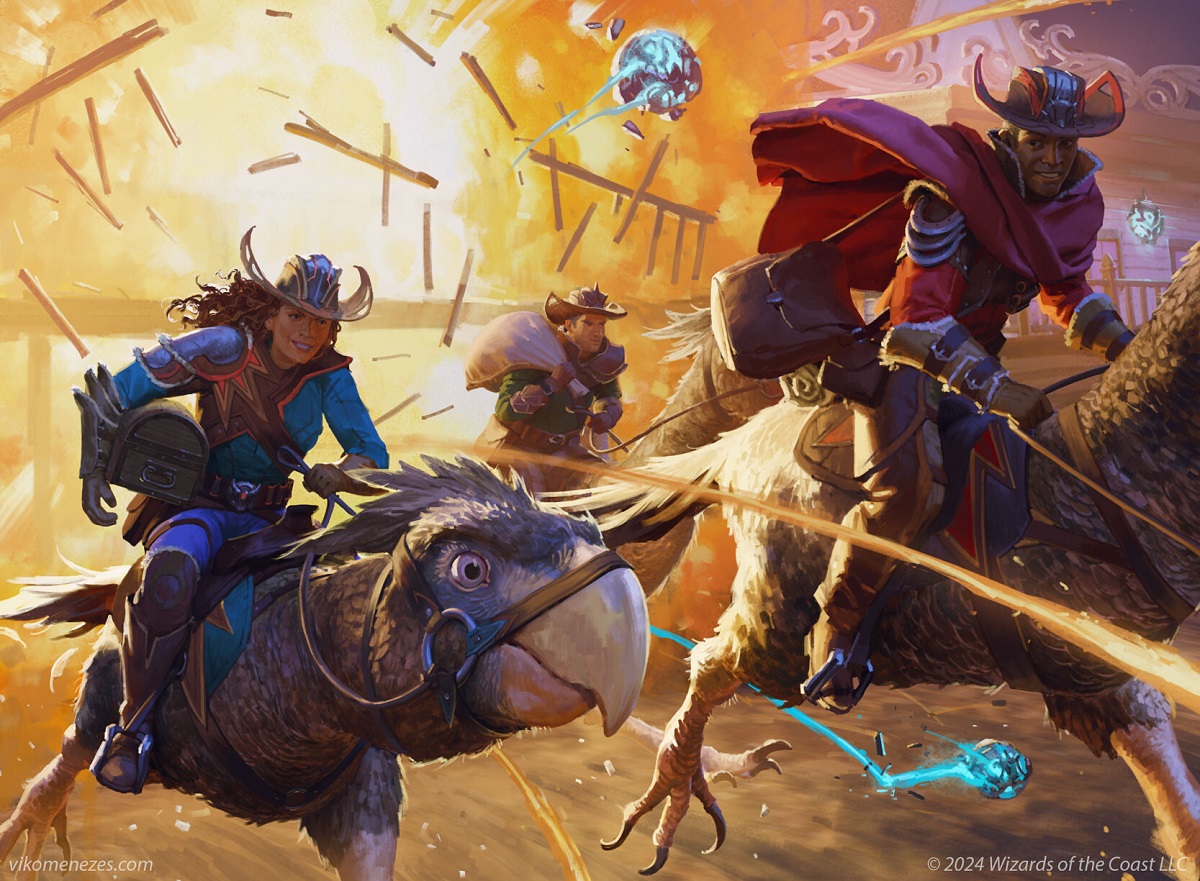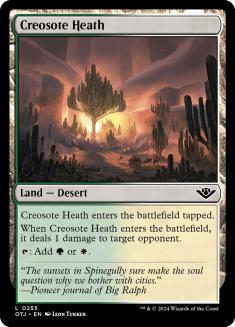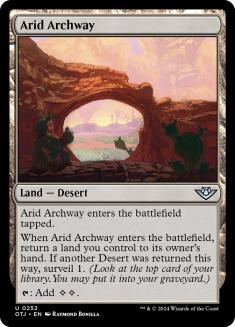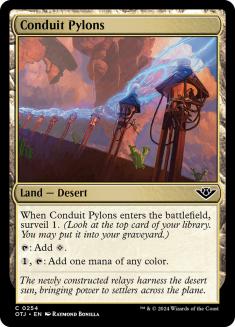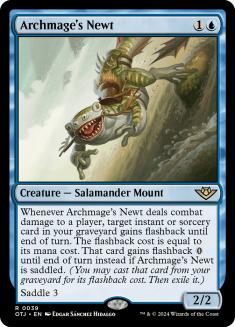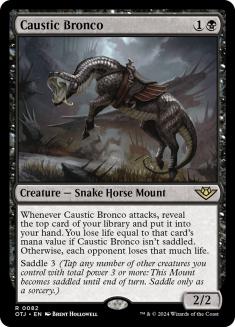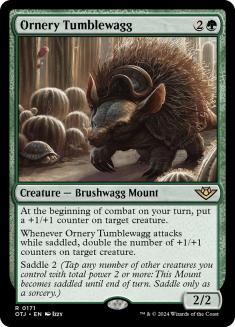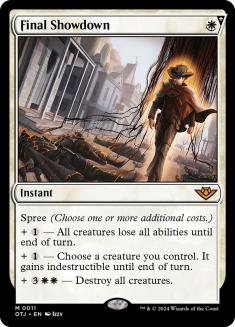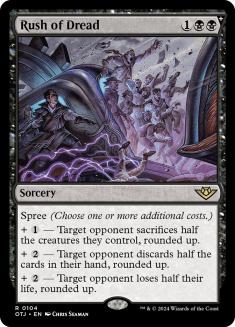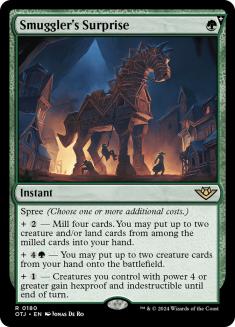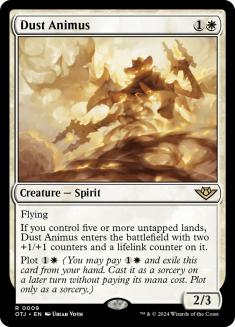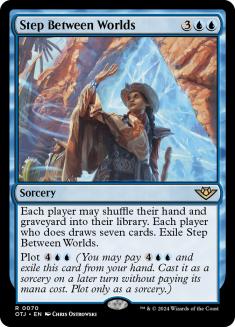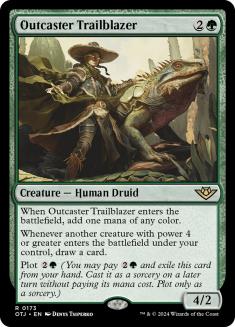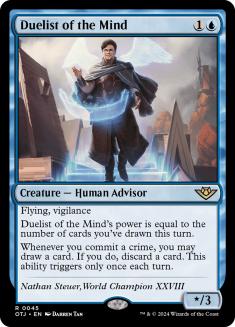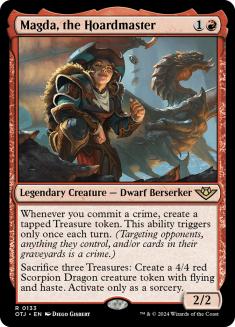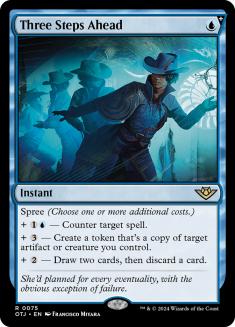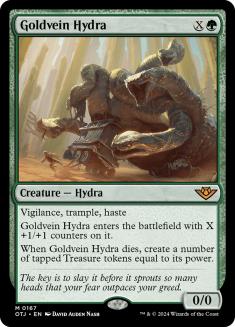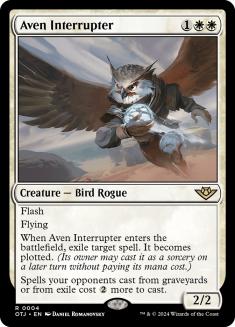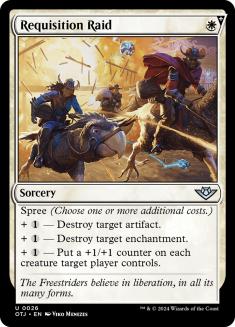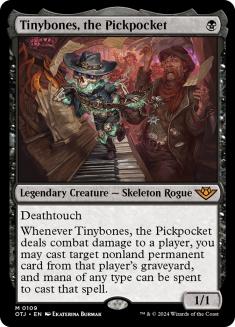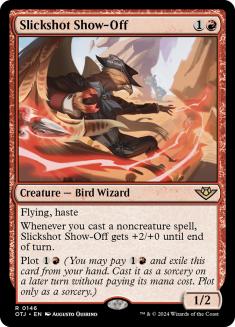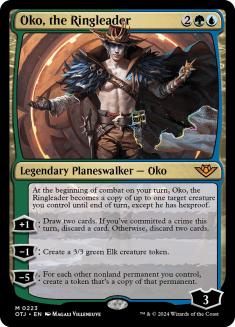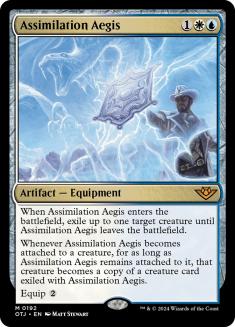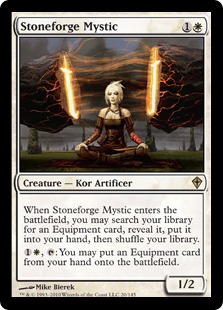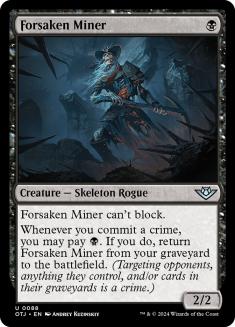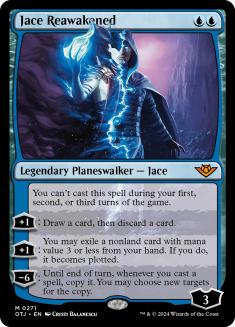Howdy gamers, and welcome to my Top 10 Cubeable cards from Outlaws of Thunder Junction! A quick caveat before we begin is that I will be treating The Big Score as a separate release as it was originally intended, and will be examining cards from BIG and Thunder Junction Commander next week.
Before I get to today’s list, let’s take a look at the broader themes and mechanics of Outlaws of Thunder Junction.
Deserts
It wouldn’t be the Wild West without Deserts, and while Deserts aren’t a land type that will matter in most Cubes, there are some Cubes that require players to draft every land that they play, right down to the basic lands. Amusingly, these Cubes are called Desert Cubes.
I can’t speak too much to this style of Cube, as I’ve never worked on or drafted one, but I can say that the full cycle of two-color Deserts that deal one damage to target opponent are nice tools for Pauper Cubes. Every common mana-fixing land entering the battlefield tapped tends to give controlling decks an edge over aggressive decks in Pauper Cubes, and as such, I’m a big fan of these lands over the cycles that gain life as a way for aggressive decks to try to push back.
Saddle
Saddle is a neat new mechanic that basically allows you to crew specific creatures for some benefit. Every creature with saddle has the new Mount creature type, which allows other cards to easily reference them. Every Mount in Outlaws comes at a pretty modest rate, so there’s not a lot to report on these cards, but it’s a neat ability and a very flavorful one at that.
Spree
Spree is a new mechanic that allows for a wider range of different modes on modal spells by offering them to players at different costs. Every spell with spree has a startup cost of sorts that you pay to cast the spell to no effect and additional costs you can pay for every mode that you wish to use on the spell.
Cards with spree run the full range of the power band, with some being generally unappealing, some being fairly modest, and some looking quite powerful. The templating takes some getting used to, but I expect this mechanic to return in future sets, given just how large the design space is for this sort of thing. Modals tend to be great for Cube, as you can offer players a lot of options with just one card slot, and you’ll definitely be seeing some of these in my Top 10!
Plot
I wrote about plot at length last week and I find the mechanic very appealing. Cards with plot are made or broken on their individual rates, but generally speaking plot gives players more options, and that tends to be a good thing as long as it’s not overwhelming. Plot is simple enough that I see it as all upside from a player experience perspective.
Crimes
Finally, we come to “committing crimes” being referenced on cards. Committing crimes refers to targeting an opponent or any of their things in non-exile zones. I would only expect this phrase to show up in sets where it’s especially flavorful, but I wouldn’t expect this to be the last time we see these words on Magic cards. It is my belief that the best Cubes involve a good amount of back-and-forth gameplay and interaction, so I’m a pretty big fan of committing crimes.
Now that we know what this set is about, let’s get to my picks for the Top 10 most appealing cards for the world of Cube broadly!
10. Three Steps Ahead
I like the idea of “Cancel with upside” in Cube, with Disallow being a card I have a particular affinity for, but these cards ultimately end up being a bit below rate for most Cubes. Three Steps Ahead is more appealing than other cards in this space because it’s also a Clone with flash! Only being able to copy your own things is unfortunate, but you would almost assuredly have to pay more mana if the effect could copy opponents’ cards. When neither mode is useful, you can always just cast the card as a Catalog, which is a decent fail case. If you really want to just cast a spell, you can also just cast Three Steps Ahead for one mana to no other effect, but where things get a little wild is when you can pay the cost for multiple effects on the card.
No individual mode on Three Steps Ahead is terribly appealing, but the sum of the parts leaves a lot to like. I don’t see the card as being able to hang in something like a Vintage Cube, but at lower power levels I like it a lot. I’m specifically looking at it for Spooky Cube, which has a robust spells-matter theme as well as lots of incentives to copy your own creatures.
9. Goldvein Hydra
Similarly, Goldvein Hydra is appealing because of the sum of its parts. Vigilance, trample, and haste stack up to make this a creature you generally can’t ignore, and the death trigger can make dealing with the card a scary proposition as well!
If you’re not casting Goldvein Hydra for at least X=3, then it is ultimately a pretty manageable threat, though I would expect that you would only cast it for smaller numbers when you were choked on mana. It’s both good to have that option and potentially great to cast it and stop your opponent from having good attacks in those spots simply because the Hydra dying will enable you to cast more threatening spells. I’m going to give this one a whirl in the original Twobert at the very least.
8. Aven Interrupter
There’s a lot of competition when it comes to three-mana white creatures, but another cheap white threat with flash helps to enable more robust Azorius flash decks and to allow Mono-White Aggro decks to play more on opponents’ turns.
I could go either way on Aven Interrupter as a Vintage Cube card with how crowded the three-mana slot is, but the fact that it taxes any spell cast from a graveyard or exile and not just the card that it plots has value. It’s a strong foil to something like an Underworld Breach and is kind of a combo with Elite Spellbinder!
7. Requisition Raid
Disenchant is fine enough in a good amount of Cubes, and I would be lying if I said it wouldn’t make a lot of my Vintage Cube decks. Requisition Raid is slightly worse than Disenchant at what it does for being a sorcery, but in exchange, you can use it to destroy both an artifact and an enchantment, and/or to pump your team.
Again, this card is a little weak if you’re only using one of its modes, but every mode only costing one additional mana makes it so that, almost any time you’re using two or more modes, the card will be excellent. There are a lot of options in the way of Disenchants these days, but from Peasant Cubes to Vintage Cubes, there is something appealing here.
6. Tinybones, the Pickpocket
Tinybones, the Pickpocket dies to everything and can’t attack through a Saproling token, but I think reading the card and correctly identifying that there is some difficulty involved in leveraging its hit trigger is the wrong way to approach the matter.
Instead, I would offer that Typhoid Rats makes a lot of retail Limited decks and can be really annoying to try to attack through. Tinybones has massive upside over a basic Typhoid Rats in that it can generate some real value when it attacks. While it is true that Tinybones dies to everything, your opponent will often have incentive to actually use that removal spell. That’s a big deal when we’re talking about a one-mana creature!
Your opponent does have to play ball a little by having a nonland permanent that you can cast in their graveyard to really make use of Tinybones, but that’s very likely in a lot of Cubes where creatures are the most common creature type. It’s not really a Vintage Cube kind of card, but I expect it to be kind of a sicko in the Tempo Twobert.
5. Slickshot Show-Off
For my money, Slickshot Show-Off is easily the Constructed standout of Outlaws of Thunder Junction. I actually don’t personally intend to Cube with it beyond slotting it into the Tempo Twobert, but it’s a Wizard and it attacks for millions of damage in a good spells-matter deck.
My issue with the card in most Cubes is the same issue that I have with Soul-Scar Mage. If you’re not reliably casting noncreature spells, these cards have unimpressive bodies. Soul-Scar Mage is among the least appealing cards in recent runs of the Magic Online (MTGO) Vintage Cube because it’s so weak in the sorts of red aggressive decks that tend to show up in traditional Cubes. In Cubes where you really lean into prowess, it can shine, which is exactly where I put Slickshot Show-Off.
4. Oko, the Ringleader
Impressions of Oko, the Ringleader suffer from how much weaker the card is than Oko, Thief of Crowns, but this isn’t a reasonable standard to hold any card to. On its own merits, the new Oko is something of a powerhouse in its own right.
I love Garruk Wildspeaker more than most, so a four-mana planeswalker that makes a 3/3 and sticks around with two loyalty does it for me. Initially, I thought Oko’s plus ability was fairly weak the turn that you cast it, but this is mitigated entirely by how little loyalty it takes to ultimate Oko. After a couple of turns of looting, I find it hard to believe that you won’t be able to completely take over a game if this planeswalker goes uncontested.
Beyond that, Oko’s static ability is kind of messed up. If you’re ahead at all when you cast Oko, suddenly you can double-up on your existing threats or functionally give your more expensive creatures haste as you cast them. You do want to be careful about Oko getting into combat, given that it doesn’t have a Gideon-style damage prevention ability to protect its loyalty, but copying creatures with activated abilities or haymakers like Inferno Titan should close games in short order.
3. Assimilation Aegis
A gold Oblivion Ring that only hits creatures is a rate that Magic left behind years ago, so I’m sure this one reads as being weirdly high on my list at a glance. I have two reasons to put this card where I did.
First, it’s a catch-all creature removal spell that you can find with Stoneforge Mystic. This alone puts the card way over for almost any Cube that features everyone’s favorite Kor Artificer.
Perhaps more significantly, this card creates stories. Making your creatures into copies of the creature you exiled allows for completely out-of-control swings in games. Assimilation Aegis isn’t on the level of Fractured Identity, but that’s a Vintage Cube-only kind of card. Despite being far more modest on power level, it will still lead to awesome turns where you answer your opponent’s best creature and suddenly your Soldier token is swinging for some berserk amount of damage as a copy of that creature. Stuff like that is what keeps us coming back.
2. Forsaken Miner
Black has a long roster of sticky creatures these days, and while not being able to block is a real drawback, the upside on returning from the graveyard to the battlefield for only one mana is too high to ignore. Skeleton and Rogue are both creature types with a decent amount of support, but this one is showing up in every Cube with a Sacrifice theme. The interaction with Priest of Forgotten Gods is too free, and the wombo-combo with Goblin Bombardment can hang from Peasant Cube all the way to larger Vintage Cubes.
1. Jace Reawakened
Jace, like Oko, suffered from some perception problems during preview season. The interaction with Valki, God of Lies was pointed out early and is very powerful, though there was also talk of using the card in conjunction with Leyline of Anticipation, which is sillier, and that kind of thought makes it easy to dismiss the card as a meme. The longer that I’ve sat with the card, the more I think it’s just awesome.
You can’t cast Jace until Turn 4, which does really matter in Vintage Cube where you want to get going early, but even there it’s not as extreme as something like Lotus Bloom. Once you can cast Jace, you spend a mere two mana and have access to a planeswalker right away. There’s give and take with Jace as compared to other two-mana looters, but dodging creature removal and being able to loot immediately are both significant points in Jace’s favor.
Only being able to plot cheap spells might not look especially powerful, but I would argue that this ability makes Jace really strong in any draw-go style deck that has other threats that it wants to stick. Monastery Mentor, for example, really struggles to hang in Cube given how quickly it dies to any removal spell, but being able to plot your Mentor and then cast it with all of your mana up enables you to immediately make a bunch of Monks even if your Mentor dies. Now replace the Mentor with any other threat and the barrage of spells with any removal spell and any counterspell, and it’s easy to imagine a game where this Jace can be awesome. And when it’s weak, it costs two and it loots. How weak can it really be?
Outlaws, Cubed
Outlaws of Thunder Junction is a pretty modest set on power level, which is just fine by me. I definitely enjoy that card complexity is much lower than for Murders at Karlov Manor. There’s a good spread of Cube goodies, and even more when you factor in The Big Score, which I’m so glad didn’t end up being released as another awful Aftermath set. Tune in next week when I highlight even more new Cube cards from BIG as well as Thunder Junction Commander!

